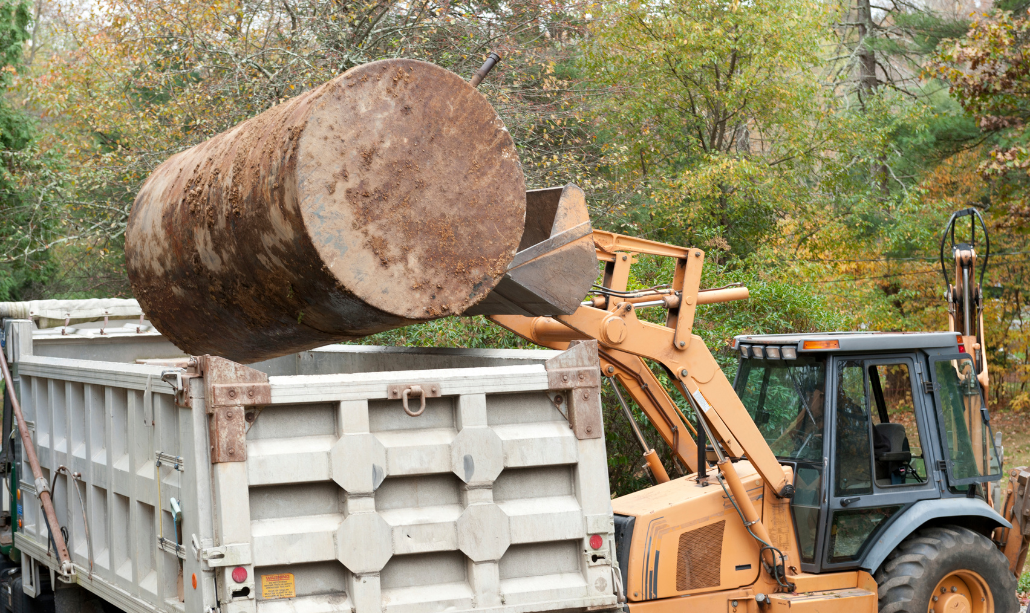When considering the purchase of a property, the presence of an underground oil tank (UST) is a critical factor that warrants thorough examination. These tanks, often remnants of outdated heating systems, can pose significant environmental and financial risks if not properly addressed.
Understanding Underground Oil Tanks
Definition and Common Uses
Underground oil tanks are large containers buried beneath the property’s surface, historically used to store heating oil for residential or commercial buildings. While many have been decommissioned, some still remain in use or have been improperly abandoned.
Historical Context: Why Are They Underground?
In the past, burying oil tanks was a common practice to protect them from the elements and to save space. However, over time, these tanks can corrode and develop leaks, leading to environmental contamination.
Potential Hazards: Leaks, Soil Contamination, and Environmental Impact
A leaking UST can contaminate the surrounding soil and groundwater, posing serious environmental and health hazards. Cleanup efforts can be extensive and costly, often involving soil excavation and disposal.
Identifying the Presence of an Underground Oil Tank
Visual Indicators on the Property
Look for signs such as old oil fill pipes, vent pipes, or areas of disturbed soil. These may indicate the presence of a UST.
Utilizing Professional Inspection Services
Engaging a professional inspector experienced in UST detection is advisable. They can conduct thorough assessments, including soil testing and tank integrity tests.
Importance of Early Detection
Identifying a UST early in the property evaluation process allows for informed decision-making and negotiation. It also helps prevent unforeseen environmental issues after purchase.
Evaluating the Condition of the Oil Tank
Age and Material Considerations
The lifespan of a UST depends on its material and the surrounding environment. Older tanks are more susceptible to corrosion and leaks.
Common Signs of Wear and Potential Leaks
Indicators include oil odors, stained soil, or a sudden increase in oil consumption.

Role of Regular Maintenance and Testing
Regular inspections and maintenance can prevent leaks and extend the tank’s lifespan. Testing methods include pressure testing and soil sampling.
Environmental and Legal Implications
Environmental Risks: Soil and Groundwater Contamination
Leaked oil can contaminate soil and groundwater, affecting local ecosystems and potentially human health.
Legal Responsibilities of Property Owners
Property owners may be held liable for environmental damage caused by a leaking UST, regardless of when the leak occurred.
Financial Consequences: Cleanup Costs and Liability
Cleanup costs can be substantial, often ranging from thousands to tens of thousands of dollars. Liability may also include fines and legal fees.
Options for Addressing Underground Oil Tanks
Removal vs. Abandonment: Pros and Cons
- Removal: Eliminates the source of potential contamination but can be costly and disruptive.
- Abandonment: Involves filling the tank with an inert material and leaving it in place; it’s less expensive but may not be suitable if the tank is leaking.
Steps Involved in Proper Tank Removal
- Assessment: Determine the tank’s condition and the extent of contamination.
- Permitting: Obtain necessary permits from local authorities.
- Excavation: Carefully dig up and remove the tank.
- Disposal: Transport the tank to a certified disposal facility.
- Remediation: Address any contaminated soil or groundwater.
Importance of Hiring Certified Professionals
Due to the environmental and legal complexities, it’s crucial to hire professionals certified in UST removal and remediation.
Impact on Property Value and Insurance
How Underground Oil Tanks Affect Property Resale Value
A property with a known UST may be less attractive to potential buyers, potentially lowering its market value.
Insurance Considerations and Potential Coverage Issues
Some insurance companies may refuse to provide coverage for properties with USTs, or they may charge higher premiums.
Impact on Property Value and Insurance
Strategies for Mitigating Negative Impacts
To safeguard your property’s value and ensure comprehensive insurance coverage, consider the following strategies:
- Proactive Tank Management: Engage in regular inspections and promptly address any identified issues to prevent leaks and environmental contamination.
- Transparent Communication: When selling your property, fully disclose the presence and condition of the UST to potential buyers to build trust and facilitate a smoother transaction.
- Insurance Consultation: Work closely with your insurance provider to understand policy options and ensure adequate coverage for properties with USTs.
Regulatory Framework and Compliance
Overview of Relevant Environmental Regulations
Understanding and adhering to environmental regulations is crucial for property owners with USTs. Key considerations include:
- Federal and State Regulations: In the U.S., the Environmental Protection Agency (EPA) sets guidelines for UST management. However, specific regulations can vary by state.
- Regular Compliance Checks: Stay informed about changes in regulations and ensure that your UST meets all current standards.
Ensuring Compliance to Avoid Penalties
Non-compliance can result in significant fines and legal actions. To maintain compliance:
- Scheduled Inspections: Conduct routine inspections as mandated by local regulations.
- Proper Documentation: Maintain detailed records of all inspections, maintenance, and any incidents related to the UST.
Best Practices for Buyers: Conducting Due Diligence
Essential Steps Before Purchasing a Property with an Underground Oil Tank
If you’re considering purchasing a property with a UST, it’s imperative to:
- Engage Qualified Inspectors and Environmental Consultants: They can assess the tank’s condition and identify potential environmental risks.
- Review Seller Disclosures: Obtain and scrutinize all relevant documentation from the seller regarding the UST.
- Understand Legal Implications: Be aware of the liability and responsibilities that come with properties containing USTs.
Conclusion
Purchasing a property with an underground oil tank presents environmental, legal, and financial considerations. By conducting thorough due diligence, adhering to regulations, and implementing proactive management strategies, you can mitigate risks and protect your investment.
Frequently Asked Questions
What are the dangers of buying a property with an underground oil tank?
Potential risks include environmental contamination from leaks, legal liabilities, and possible financial burdens due to cleanup costs.
How can I tell if a property has an underground oil tank?
Look for indicators such as old oil fill pipes, vent pipes, or areas of disturbed soil. Hiring a professional inspector can also assist in detection.
What should I do if I discover an underground oil tank on my property?
Consult with a certified professional to assess the tank’s condition and determine appropriate actions, which may include removal or proper abandonment.
Are there financial assistance programs for oil tank removal?
Some states offer financial assistance or grants for UST removal. It’s advisable to research available programs in your area.
How does an underground oil tank affect property insurance?
The presence of a UST can impact insurance coverage and premiums. It’s essential to discuss with your insurer to ensure adequate coverage.







Join The Discussion